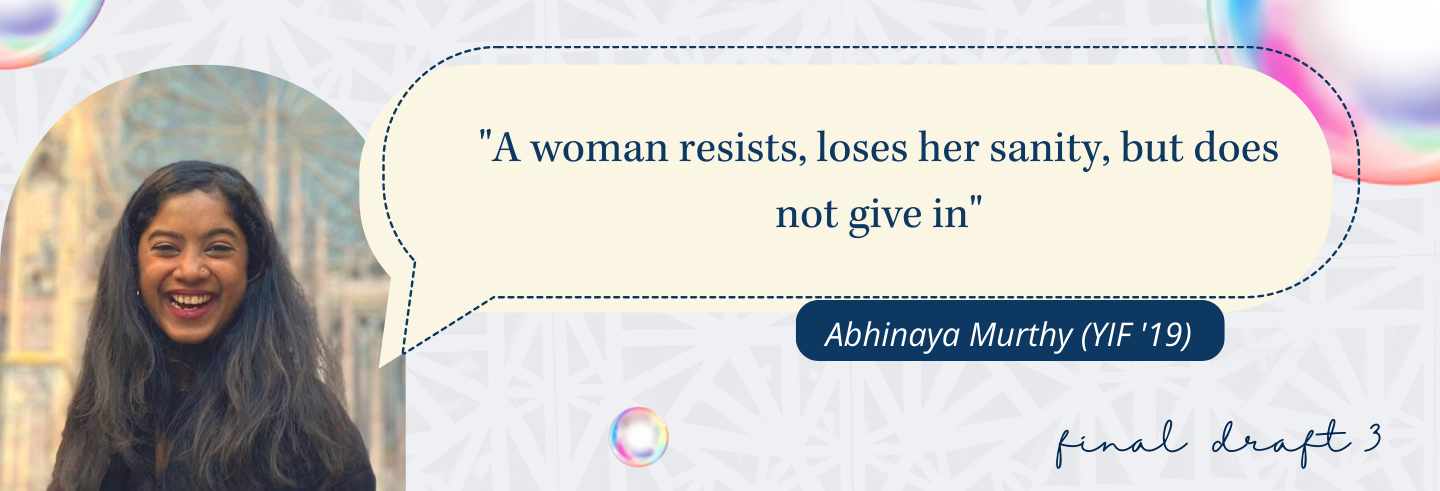The Symbol of the Wallpaper: Subjectivity and Agency in Gilman’s “The Yellow Wallpaper”
Featuring Abhinaya Murthy’s creative piece that developed as an original project over her term at the Young India Fellowship

Abhinaya Murthy
20 September, 2022 | 6m readAbstract:
A young mother confined to the four walls of her room – in the name of ‘cure’ – by her physician-husband starts interacting with the violent patterns of the wallpaper in pursuit of agency. Abhinaya re-reads Gilman’s classic short story of a woman’s struggle with ‘neurasthenia’ to conceptualize the workings of subjectivity, interpolation, and agency.
Article:
Introduction
What is a voice? Is there a latent power in muteness, or is silence to be sidelined and ignored? Is voice a marker of one’s agency? Is the dialectical subjective mind itself, expressed or unexpressed, a reflection of the conflicted self and its search for agency that inevitably becomes a part of a discussion larger than the self? Donald E. Hall argues that agency remains at the heart of discussions around subjectivity to this day. He states that we are both ‘subjects to discourse’ and ‘subjects through discourse’, and that “Agency, its possibility, and practicality, brings us face-to-face with the political question of how we can motivate ourselves and others to work for social change and economic justice …” (Hall 124). Agency is the voice of the ‘self”, and so the ‘self” has become a crucial topic for critical analysis that often finds roots in literary texts and traditions. It also transcends them in its ability to interrogate literature and culture (5).
“The Yellow Wallpaper” (1892) by Charlotte Perkins Gilman is one such short story of transgression from within the nineteenth-century convention of narratives of women’s experience of madness that gives voice to The Madwoman in the Attic. As succinctly described by Maggie O’Farrell in her introduction, the short story is “an account by a nameless young woman of a summer spent in a large country house … she is forced to dwell on the only things in front of her: the room; the grim bars on the windows; the bed, screwed to the floor; and the peculiar repetitions of the patterned, yellow wallpaper” (O’Farrell viii-ix). In this semi-autobiographical piece, Gilman writes the story of a woman going through postpartum depression. The narrator is diagnosed with neurasthenia by her husband and brother who are both reputed physicians (Treichler 61). She is forcibly made to rest in a hereditary estate, stripping her away from any and all stimulants; most importantly, she is denied any attempts at writing. During a time when hysteria was regarded as one of the ‘conventional women’s diseases’, Gilman’s carefully chosen words are urgent even in the most quiet moments (Treichler 61).
The yellow wallpaper in the short story is a metaphor—a symbol—that has been subject to much critical discourse to answer the question of what exactly it represents. Paula A Treichler and Karen Ford have explored this question in their papers “Escaping the Sentence: Diagnosis and Discourse in ‘The Yellow Wallpaper’” and “The Yellow Wallpaper and Women’s Discourse” respectively. The former argues that the yellow wallpaper represents women’s discourse, while the latter asserts that it is a symbol of patriarchy and that the potential of women’s discourse lies in the ‘blank spaces’ of the wall behind the destroyed, distressing wallpaper. By critically examining both the positions, this paper takes a new position: the yellow wallpaper symbolises the conflicted subjectivity of the narrator which oscillates between her desire for agency geared towards production of women’s discourse, and the necessity to conform to patriarchy and its silencing discourse of diagnosis.
The Patriarchal Language of Diagnosis
Treichler associates nineteenth-century psychiatric ‘diagnosis’ with ‘patriarchal sentencing’ in her paper. She defines diagnosis as “a ‘sentence’ that is simultaneously a linguistic entity, a declaration of judgement, and a plan for action in the real world whose clinical consequences may spell dullness, drama, or doom for the diagnosed” (70). Further, she speaks of a language that is patriarchal, particularly in medical discourse, and which constructs women in the image of domestic slavery, reducing them to a social and economic dependence (64). Her position of the wallpaper representing women’s discourse comes from her argument of the narrator ‘escaping the sentence’ through her interactions with the wallpaper in the short story. Treichler introduces the concept of feminist linguistic innovation and extrapolates this with escaping patriarchal sentencing. She does this by vocalising the ‘unheard-of contradictions’ in the subjectivity of an active, desiring female subject: a woman rising against false diagnoses and unconforming to her submission to a ‘superior’ gender (Gilman 6). Treichler also discusses the idea of breaking free from a restrictive language constructed by the male order—responsible for the clinical conditioning of female desire, power, and individuality—demystifying what is considered to be pathological behaviour. The wallpaper, at the very beginning of the story, commits ‘every artistic sin’ according to the unnamed narrator (Gilman 6). It is interesting to note that something unconventional and unappealing to the narrator is connotative with the word, ‘sin’. The dominant ‘artificial feminine self” of the narrator, at this point, is a sweet, obedient wife who regulates her behaviour during sickness according to the rules imposed by her husband’s patriarchal diagnosis and the conservative society at large (Treichler 61). Anything that breaks this order would be sinful. Using the yellow wallpaper as a metaphor, the unheard-of contradictions surface in unconventional patterns that are alien to a mind that has been exposed to, and has even internalised, plain patterns that obey and submit to conventions.
Conditions of Speaking and the Possibility of a ‘Forbidden’ Women’s Discourse
Treichler questions the patriarchal syntactical conventions of language by engaging with the unconventional patterns of the wallpaper and by analysing the wallpaper’s symbolism through a feminist lens. In the duality of diagnosis as sentencing which entails semiotic relations on one hand, and the question of representation in language on the other, Treichler states that “diagnosis is a set of representational practices” (65). In exploring the relationship between language and reality, she posits reality is constituted of language; that it is essentially linguistic in nature. “The sentence for a woman is bound inescapably with symbolic order”, and thus, the reality of female language is “not concerned merely with speech, but with conditions of speaking” (71). The conditions of speaking is the environment the speaker is in and that in which words are being spoken. This is precisely why the narrator in “The Yellow Wallpaper” engages in expressing her views which Treichler describes as ‘forbidden discourse’ because of the narrator’s understanding of her own oppressive environment. “I did for a while write in spite of them; but it does exhaust me— having to be so sly about it, or else be met with heavy opposition” (Gilman 4). The subject is also “subject[ed] to discourse, and a subject of knowledge, most familiar with perhaps, of the discourses of social institutions that circumscribe its terms of being” (Hall 3).
This forbidden discourse is consistently situated in conflict within the story, from definitions to descriptions to analyses. The narrator defines John as ‘practical’ and herself as ‘sensitive’ (Gilman 3–5). While she confides in her journal (to ‘dead paper’) that John is falsely diagnosing her, she is compelled to listen to a physician of high standing (Gilman 3). Elaine Showalter points to this duality in saying that contemporary feminist philosophers, literary critics, and social theorists have “shown how women, in the dualistic systems of language and representation, are typically situated on the side of irrationality, silence, nature, and body while men are situated on the side of reason, discourse, culture, and mind” (4).
In the short story, John also seems to view the narrator’s writing as merely ‘fancies’ which she should try her best to not give in to as ‘her imaginative mind’ will hinder her recovery (Gilman 8). The question to ask in this context is, as artists, what are some of the barriers that women face in practising their work professionally? Will it always come second to the duties of motherhood and wife? In her book But Is it Art? Cynthia Freeland illustrates how women have been pathologically enforced to restrict, or even give up, artistic expression lest they disrupt their primary gender responsibility and occupation of looking after the household (Freeland 136). Freeland does this by taking examples of potters Maria Martinez and Nampeyo who “made pottery while attending to household chores, child-care and the significant ritual responsibilities of Pueblo ceremonial society” (128). Musician and composer Fanny Mendelssohn Hensel, while being a gifted musician, was also restricted from working by her brother who wrote to their mother stating that Fanny is “too much of a woman” to take authorship seriously and should only do so after her “primary occupation” (domestic duty) is accomplished, and that “publishing would only disrupt these duties …” (136). While Freeland does not discuss female writers in this section of her book, her arguments related to restrictions placed on female artists across genres are compelling.
In the short story, John brings the narrator to the mansion as she was unable to care for her child (due to postpartum depression). Consequently, the environment that is created for the narrator does the opposite of aiding her recovery: John’s constant patronisation and infantilisation of the narrator alongside the role of John’s sister who is described as a “perfect and enthusiastic housekeeper who hopes for no better profession” creates an oppressive patriarchal setting (Gilman 7–10). Therefore, the narrator is rendered a subject to discourse, whose subjectivity initially reflects the predominance of patriarchal conditions that she is placed in and the strong grasp of forces of interpellation.
However, as the story progresses, and as the association with the wallpaper deepens, the voice of the narrator undergoes a radical transformation. It grows from a “crowing, impertinent language to rude, direct language” (Treichler 73). In the following instance, the narrator speaks but is still restrained by the system:
I don’t know why I should write
this:
I don’t want to.
I don’t feel able.
And I know John would think it
absurd. But I must say what I feel
and think
in some way—and it’s such a relief!
But the effort is to be greater than
the relief. (Gilman 12)
This duality in thought represents her oscillating mind. Her conflicted subjectivity oscillates between breaking free (desire for agency/becoming a subject through discourse) and caging herself in (forces of interpellation/ subject to discourse). John is still playing the role of the oppressor and she, struggling to break free from it. Treichler does identify that the wallpaper could symbolise the ‘narrator’s unconscious’ but holds her ground on the metaphor of women’s discourse emphasised by structures of patriarchy that alienate the narrator from work and intellectual life (62). However, the narrator’s unconsciousness is crucial to the construction of potential agency. By the end of the short story, her impertinent voice gains confidence and transforms into something more direct and imposing when she says, “I’ve got out at last … you [John] cannot put me back!” (Gilman 23). This defiant voice of the narrator, demanding agency, contains the potential of engendering women’s discourse even though it is marred by the ‘punishment’ of madness.
Symbolism of the Wallpaper: A Parable of Subjectivity and Agency
Karen Ford, on the other hand, aptly observes that the narrator grows more and more silent as she begins to engage further with the wallpaper. Ford unpacks the contradictions in the narrator’s language. The narrator is constantly interrupted; her only counter to John’s dictum is by literally “refusing to speak, or metaphorically, by revealing the blankness behind the paper” (Ford 311). This silence, according to Karen Ford, signifies patriarchal muting of women’s voices and a surgical removal of their agency from their narratives, making the wallpaper an embodiment of male discourse. She further discusses the space occupied by female discourse in the male order by stating that the narrator, if she discovers women’s discourse in any sense, “is in the blankness behind the wallpaper” (312). When the narrator finds that other women (who she soon identifies with) are trapped behind the paper, she tears the wallpaper down to set them free. “They get through and then the pattern strangles them off” (Gilman 19). Ford draws upon what Gauthier calls “the new space” that points to “aspects of feminine writing which are most difficult to verbalize because it becomes compromised, rationalized, masculinized as it explains itself” (312). Ford thus argues that in getting to the blank spaces, the narrator and other women trapped within male discourse will find an alternative new space which is outside male influence.
But what happens to her agency, when she gets to the blank spaces behind the wall? Ford states, “Is this freedom of expression, and if so, at what cost does she achieve it?” (312). On the other side of the wallpaper, the narrator emerges mad, creeping on the floor and tied to a rope (Gilman 23). In Treichler’s initial paper on escaping the sentence, she argues that this final image serves a sentence that “seeks to escape the sentence passed by medicine and patriarchy” (Treichler 70). She also notes, “to ‘escape the sentencing’ involves both linguistic innovation and change in material conditions: both change in what is said and change in the conditions of speaking” (74). Treichler’s position of the yellow wallpaper symbolising women’s discourse stems from the realisation that the narrator becomes an “involved language user, producing sentences that break established rules … which changes the terms in which women are represented in language and extends the conditions under which women will speak” (74). Both Treichler and Ford’s positions discuss how the subject is situated in conditions put in place by male-ordered sentencing.
In her attempt to exceed the sentence, the narrator in “The Yellow Wallpaper” does not manage to escape it. In her response paper “The Wall Behind the Wallpaper: Response to Carol Neely and Karen Ford”, Treichler argues that the blank spaces may point to linguistic practices evolving “outside the policed territory of specific discourses” but it is pertinent to understand that “women’s discourse is never truly ‘alternative’ but inhabits the same terrain as the ‘patriarchal discourse’ it challenges” (324–25). In light of this, revisiting the final image of the narrator tearing down the wallpaper while tied by a rope and locked in a room, she succeeds in forcing a new diagnosis of being sick, overthrowing her earlier conformity to male-prescribed language. However, she is not free from the severe consequences of being sent to Weir Mitchell for treatment (327). “Woman stands before man not as a subject but an object paradoxically endued with subjectivity; she takes herself simultaneously as the self and the other, a contradiction that entails baffling consequences” (Beauvoir, qtd in Hall 98–99). The narrator’s conflicting self and other, thus performs the duty of exercising agency while being limited by forces of interpolation.
Donald E Hall borrows from Butler to build his discussion of potential agency on the idea that agency is a part of ‘being’, and this ‘being’ is a “potentiality that remains unexhausted by any particular interpellation” (Butler, qtd in Hall 127):
[T]he expanded notion of potential agency [is one] that approaches the optimism of Giddens without ignoring the limitations resulting inevitably from the interpellative process and the parameters of discourse itself. If the subject can choose for close contestatory connections, then certainly it has an always limited but still significant ability to allow those contestatory connections, or at least to recognise their possibility. (Hall 128)
This idea of potential agency paving ways to recognise the possibility of transgression and identifying contradictions as part of having this subjectivity which is not absolute (as humans err), substantiates my chosen position of the wallpaper symbolising the narrator’s subjectivity with limited agency. This conflicted subjectivity allows the narrator to tear the wallpaper in certain moments and be one with it in others. Treichler outlines these moments of tearing as moments of escape. While the diagnosis itself is a “consequence to a death sentence” (Treichler 71), a sentence that entails a life that suppresses desire and individuality, a “stimulus-less environment” (Gilman 15) which constructs a life not worth living at all; the consequence of this is the narrator experiencing unheard-of contradictions. And by freeing the woman inside the wallpaper, which she also identifies as herself, she ‘escapes the sentence’. Hall quotes Butler in saying that “exceeding is not escaping. The subject exceeds precisely that to which it is bound” (Hall 127).
The Female Malady and Struggle for Agency
The conditions to which she is bound vividly come alive at the end of the story. The narrator’s conditions of speaking change as she repeatedly instructs John to find the keys to the room. Treichler argues that while this repetition can be a sign of madness, it is in fact an example of John (the patriarch) being “unable to accept a statement of fact from her, his little goose” (73). A woman resists, loses her sanity, but does not give in. Stories like “The Yellow Wallpaper” make a strong statement that women, both writers and characters, are “proving that language can be both powerful and womanly” (Ford 314). While language is powerful enough to break stereotypes in writing female characters and also in redefining how women are viewed and spoken about at large, “The Yellow Wallpaper” is a story of transgression because it challenges the narrative of the female malady. In the introduction to her book The Female Malady, Elaine Showalter points to the three major images of the madwoman: “the suicidal Ophelia, the sentimental Crazy Jane, and the violent Lucia”––in all three stories in which the heroines’ attempts to break free end in them being driven to madness or suicide or both, endorsing madness as a desired form of rebellion (Showalter 5). While the heroines rebelled, they were also unmistakably tied to their affection towards their respective male counterparts. The image of Crazy Jane particularly is “a flattering reminder of female dependence upon male affection” (Showalter 13). In adaptations of these cultural images in opera as well, depiction of the female malady is bound to male domination:
But to watch these operas in performance is to realize that even the murderous madwomen do not escape male domination; they escape one specific, intolerable exercise of women’s wrongs by assuming an idealized, poetic form of pure femininity as the male culture had construed it: absolutely irrational, absolutely emotional, and, once the single act is accomplished, absolutely passive. (Showalter 17)
Showalter then highlights that the psychiatric interpretation of madness in women, and by extension, in narratives around it, are the product of male culture which silences female discourse. Stories produced out of this culture may dignify or romanticise the death of the heroines or their descent into madness. But Ford makes a poignant statement when she says that while there can be some dignity or victory in these resolutions into madness when compared to a domesticated enslavement of women, they are not ultimately acceptable. “As the holes, blanks, gaps, and borders [that Gauthier proposes as sites of women’s language] are no substitute for words on the center of the page; lethargy, depravity, and suicide are not alternatives to a fulfilling life” (Ford 313).
The question to ask is, do we read these narratives as that of resistance and agency or of wasted life? Short stories like “The Yellow Wallpaper” challenge the ‘death sentence’ delivered by male-dominated medical discourse, and take up space within the dominant patriarchal discourse to give utterance to women’s discourse. As we journey with the narrator and her conflicted subjectivity, we also journey through the terrains in which freedom is defined. While the story begins with an image of confinement (the narrator trapped within grand ancestral halls) and ends with the visual of the narrator tied by a rope in a locked room, the narrator ‘breaks free’ from her initial conditions of speaking and exercises agency (although limited) in her resistance.
Both Karen Ford and Treichler’s positions of what the wallpaper symbolises cease to consider the fact that absolute freedom is a myth. Treichler, by saying that the metaphor of the yellow wallpaper is “truly never resolved” places the contradicting thought of enslavement in a struggle for escape within parentheses (75). Ford, on the other hand, strengthens her argument of the wallpaper symbolising patriarchy as it leaves the narrator in a self-tied rope. However, there is a more realistic argument of limited freedom to be made: agency in certain moments while co-option in others. How can one know freedom if one does not know restraint? The rope represents the confines that define freedom. It represents a liberated woman who is still a part of the patriarchal system. It speaks volumes of the fact that liberation cannot occur overnight, or in this case, over the course of three months— during their stay in the mansion. By representing the narrator’s subjectivity, giving her voice and agency, women’s discourse does not tie itself to attaining absolute freedom but around creating a space for negotiation of freedom by women themselves. It recognises that the relation between power and agency is always dialectical in nature, shifting scales in various moments in an individual’s life. Hall, quoting Butler says, “Agency is the assumption of a purpose unintended by power … to claim that the subject exceeds is not to claim that it lives in some free zone of its own making” (127). Therefore, the yellow wallpaper, at its centre, has a voice that vocalises unheard-of contradictions in its patterns, gives the narrator her space to act on patriarchal diagnosis and sentencing, and allows for the possibility of creation of women’s discourse in the process of recounting the struggles in the narrator’s subjectivity. The yellow wallpaper becomes the agent and medium of creation of women’s discourse but as a metaphor represents the subjectivity of the narrator—a subjectivity both as flawed and organic as the specks and scratches on the paper.
About the Author:
My exploration into creative writing began at age 11. Stories helped me interpret society and my place in it. However, I found academic writing to be the boring, rigid cousin of creative writing. At YIF, my views were challenged. I realized that any piece of writing needs to reflect critical thought. From the beginning, I enjoyed the process of critical reading, thinking, and writing. My preceptor made me realize that first drafts are never meant to be perfect and through peer reviews, my classmates helped me grow too. Writing took center stage as I worked in marketing and communications. In 2008, I had fallen in love with reading and writing, and a decade later, I fell in love again after a year of immersing myself in learning and unlearning, feedback, and assessment at YIF. I suppose one should find themselves lucky if one falls in love twice right?
Abhinaya is pursuing an M.Sc in Media, Communication, and Development at the London School of Economics and Political Science with a focus on digital inequalities. Stories, and feminist literature, in particular, continue to play an integral role in the way she understands the world.
About YIF CW Programme:
The YIF Critical Writing programme is a unique, one of a kind opportunity for Fellows to hone their critical thinking and writing skills under the able supervision of trained experts in the field. The CW programme employs a constantly evolving pedagogy, making learning and knowledge production more collaborative and dialogic. Preceptors at the YIF CW programme teach writing through a range of topics including but not limited to ‘History, Philosophy, and Anthropology of Science’, ‘Politics of Language and Multilingualism’, and ‘Education, Literacy, and Justice’.
About Final Draft:
The Final Draft is the annual journal of the YIF Critical Writing programme. It showcases the range in topic and genre, as well as the strength of writing in the highly diverse YIF student body. These pieces of writing, submitted by Fellows from various classes of the YIF represent only a small fraction of the variety and range of writing done over the years.
About our campaign:
Through our ‘Final Draft 3’ campaign, we hope to give you a glimpse into some of the styles and voices that have evolved, the concerns and ideas that fellows have explored and the seriousness of their engagement with writing as drafts in motion; searching for meaning and connection, which makes this more of a pedagogic exercise book.
(This was first published in the Final Draft, A Journal of the YIF Critical Writing Programme.)













